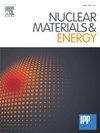Modeling input to the ITER glow discharge boronization system design
IF 2.3
2区 物理与天体物理
Q1 NUCLEAR SCIENCE & TECHNOLOGY
引用次数: 0
Abstract
The ITER re-baseline proposes changing the first wall material from beryllium to tungsten and incorporating a boronization system to mitigate plasma operation risks associated with tungsten. This system aims to deposit a 50 nm boron coating on plasma facing surfaces by fuelling diborane with a carrier gas (He, H2, or D2) in a glow discharge, based on the extensive experience from present devices. This paper analyzes the optimal number and distribution of anodes and gas injection locations for achieving a uniform boron coating in ITER. Using Monte Carlo simulations of diborane molecules in the ITER glow discharge plasma, the study examines the spatial distribution of diborane ionization and dissociation reactions, for different anode and gas injection configurations, neutral pressure, and hydrogen versus helium carrier gas concentration. The glow discharge plasma backgrounds are obtained by adapting an existing axisymmetric glow model to simulate helium–hydrogen gas mixtures. The simulation results, initially conducted with a maximum of 2 anodes, are scaled to represent a realistic anode configuration for the ITER equatorial plane. Key findings include that a low hydrogen content in helium, achieved with 5 % diborane in the carrier gas, and a low total pressure yields the best uniform boron deposition. However, thinner layers are expected where ports cannot accommodate additional anodes. Uniform gas injection points, including at the high field side, and separation of gas injection points from anodes are crucial for uniform coatings. These modeling efforts support the design of the ITER boronization system and justify expanding the ITER GDC hardware to include more anodes and gas feed points. Despite the widespread use of boronization in modern tokamaks, boron layer uniformity and its impact on plasma performance remains under-researched, highlighting the need for dedicated experiments and model benchmarking against results from current devices.
求助全文
约1分钟内获得全文
求助全文
来源期刊

Nuclear Materials and Energy
Materials Science-Materials Science (miscellaneous)
CiteScore
3.70
自引率
15.40%
发文量
175
审稿时长
20 weeks
期刊介绍:
The open-access journal Nuclear Materials and Energy is devoted to the growing field of research for material application in the production of nuclear energy. Nuclear Materials and Energy publishes original research articles of up to 6 pages in length.
 求助内容:
求助内容: 应助结果提醒方式:
应助结果提醒方式:


